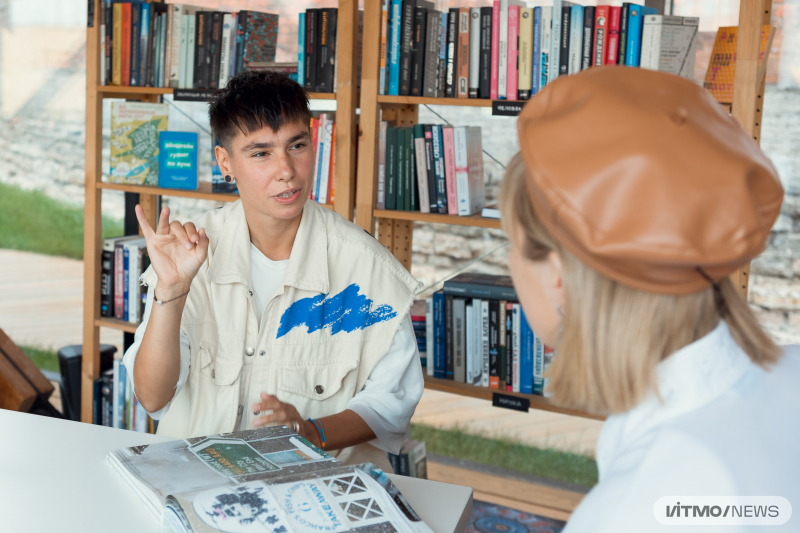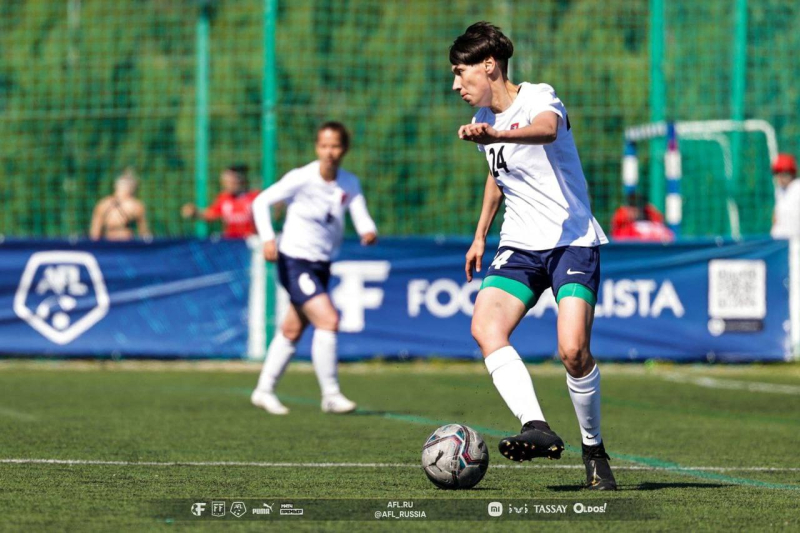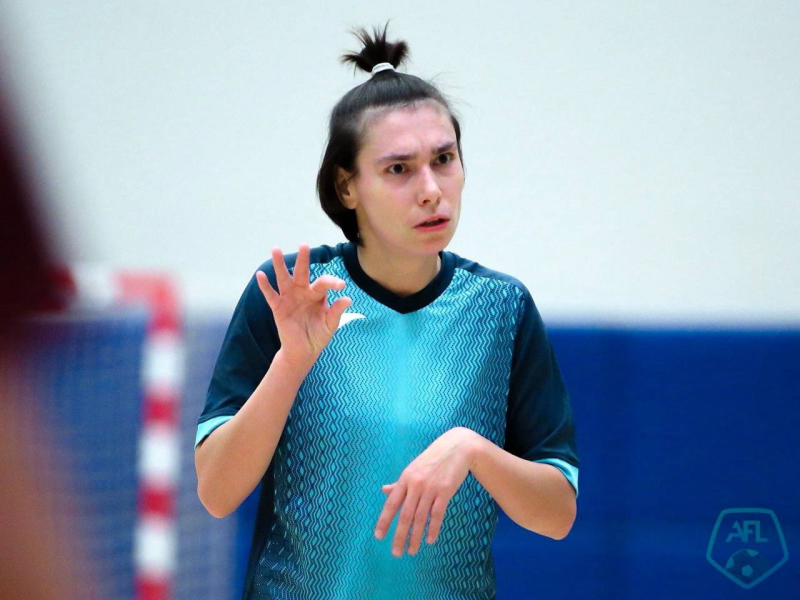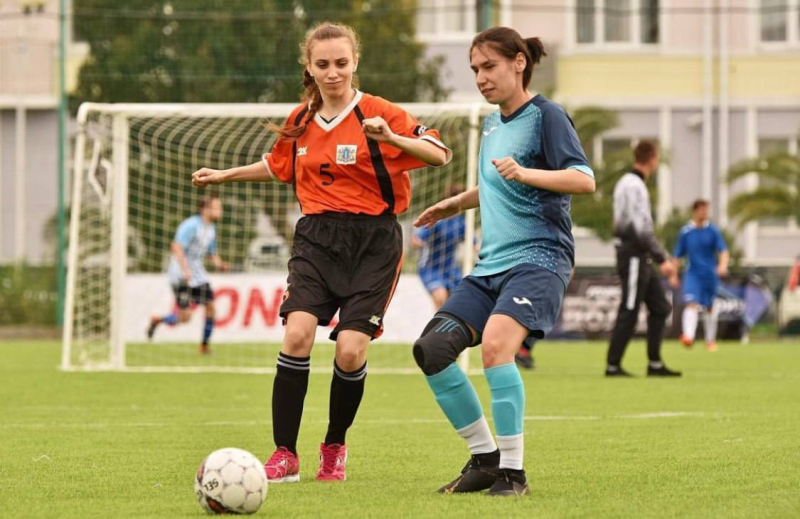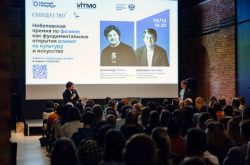A loud victory – in nearly complete silence
Even though such victories are less covered by the media than, for instance, than the European Football Championship or the World Cup, in 2017 the Russian football has seen a seminal event: the women’s team won the Deaflympics Football Tournament. Margarita Nikulina, a hard of hearing footballer from St. Petersburg, was on the team that year.
In 2017, Margarita was 28 but she has lived with deafness since she was only five. Having completed her school education at specialized boarding schools, she dreamt of training to be a hairdresser. However, since her parents couldn’t afford that, she entered the Okhtinsky vocational school, where she studied to make artwork from osier.
“I had classes alongside hearing students and only had one deaf groupmate – both of us used to sit at the back of the class. Most of the contents of our classes escaped us: we didn’t understand our lecturers; instead, we just watched the blackboard and copied everything we saw into our notebooks,” shares Margarita Nikulina.
Alongside her studies, Margarita played footbal – she has been training since she was five and has been on the national team from the age of 15. She travelled for sports to various Russian cities. However, here, too, Margarita had to face challenges: when she was 16, she fractured her ilium bone at the Russian football championship. After that, she had to leave the sport for 10 years before finding it in herself to return to practice – and achieving her biggest victory a year later.
“I used to play with the hearing, including as part of the Zenit women’s team. I also was part of the hearing beach volleyball team; even though I can’t hear, I know the game technique and tactics very well and that’s enough for me. Sometimes we compete against hearing teams – they have it easier, constantly talking during the game. For us, it’s different because we have to look at each other and communicate with signs,” explains Margarita Nikulina.
Not lost in translation
Hard of hearing individuals communicate not only with spoken words – they actively use their facial expressions, eye contact, and other non-verbal cues. However, their main means of communication is sign language. In Russia and several other countries, the deaf community uses Russian sign language. It used to be widely practiced in the USSR, especially in groups where the deaf and the hearing worked together. Moreover, many TV programs were provided with sign language interpretation.
However, things changed after 2001. According to Elena Plashchevskaya, a professional sign language interpreter and teacher, the popularity of Russian sign language went down in the 00s, as it stopped being used on TV and in public spaces. This made the Russian deaf community nearly invisible.
These days, the deaf and hard of hearing are often forced to adapt to their environments on their own. It is often the case that hard of hearing children are taught to read, write, and speak Russian by their parents – in case they themselves are hearing, says Elena Plashchevskaya. Usually, parents either learn sign language or communicate with their children in writing. In the latter case, according to Elena, the children often feel isolated from their parents; as for sign language, such children either have to pick it up from their peers or not learn it at all.
Sign language can also be learned at special schools – for instance, as a child Margarita used dactyl (a sign alphabet) and her voice to communicate with her teachers, while communicating with her peers in sign language.
However, it is hard for the deaf community to communicate with the hearing and live in an environment not adapted to their needs. According to the official statistics, there are 150,000 deaf or hard of hearing people in Russia, while about 240,000 can use the Russian sign language. Apart from specialized schools, sign language is taught at paid courses or at universities (Moscow State Linguistic University, Russian State Social University, Novosibirsk State Technical University). The majority of their students are soon-to-be sign language interpreters, lecturers for specialized schools, people with any hearing disabilities or members of their families. Only a small share of students join such courses because they wish to understand the deaf or hard of hearing individuals.
“When I am with the hearing, I communicate using my voice and actions. For example, I used to ride the BMX bike and skateboard. In these communities, you talk less and fall more, then you get up, show that you are okay, and keep going. The hearing usually knew the most common signs (mostly profane ones) and we used to teach them some more proper and practical ones. Growing up in the 90s and early 00s, I felt that the deaf and the hearing were more connected,” shares Margarita Nikulina.
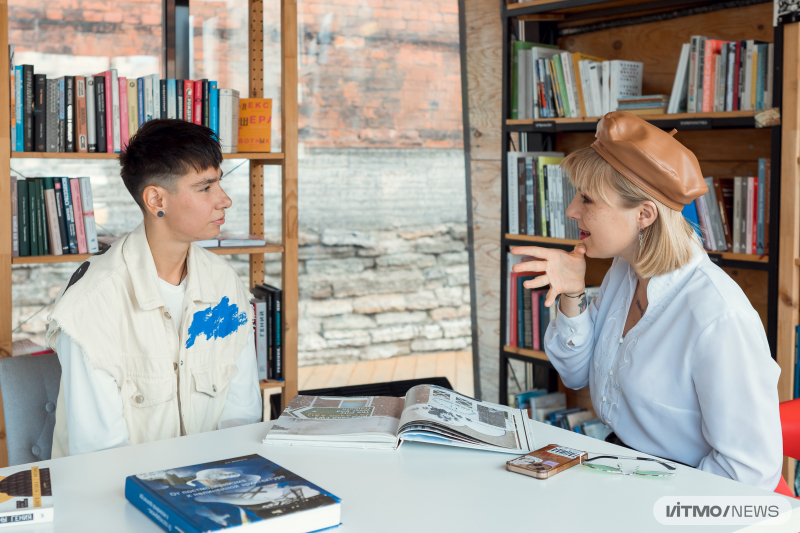
Margarita Nikulina communicating with interpreter Elena Plashchevskaya using sign language. Photo by Dmitry Grigoryev / ITMO.NEWS
A welcoming environment
Often the deaf and the hard of hearing are left to create their own inclusive environments because these are not provided otherwise, says Elena Plashchevskaya. People in the community often do livestreams or blog about their lives. The deaf hardly ever visit the cinema because not all movies have subtitles. In St. Petersburg, you can sometimes find such screenings at Rodina cinema; moreover, recently the Russian streaming platform Kion has offered sign language interpretations to some of the available films.
The case is even more difficult with other types of content, such as, for instance, science communication events. Accordion to Elena Plashchevskaya, popular science lectures are hardly adapted to the needs of the deaf community. That’s why she interprets such lectures to sign language, including in collaboration with ITMO as part of the new open lecture project organized by the university’s Center for Science Communication at Vokzal 1853 food mall.
Within the project, science communicators, journalists, clinicians, and scientists talk about the way evidence-based medicine impacts our daily lives. Each lecture is interpreted to Russian sign language by a team of professionals.
“Interpreters have to know the subject of each lecture very well. That’s why I always ask for lecture materials a week or two in advance, so that I can truly get intimate with the topic. It’s important to not just interpret everything word for word; no, the topic has to be presented in an understandable and engaging way,” adds Elena.
Moreover, it’s important to take into account the different perception of the deaf: usually, they rely on the visuals, which means that images are of particular importance, as is sign language interpretation. Additionally, it might be challenging for them to receive a lot of information in written form, especially when it’s laden with specialized terms. Any such terms, colloqualisms, or idioms should be followed by examples from the daily life.
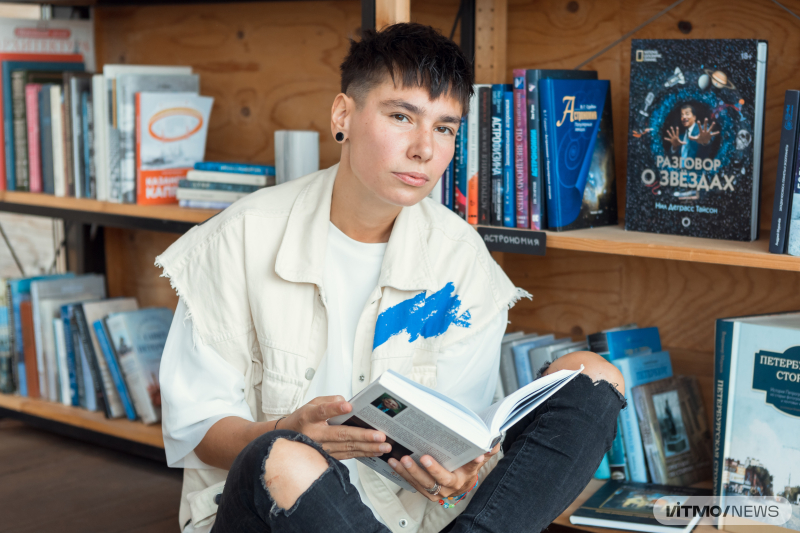
“I love studying a little bit of everything: psychology, ecology, space sciences, and history of Russia and the world. Unfortunately, however, people in the deaf community rarely have an interest in science because some of us find it challenging to read books in Russian – the sign language grammar is completely different. It may be that if science was more accessible and was interpreted to the sign language, we would have engaged in it more. For instance, I find some of ITMO’s educational programs interesting and I would love to study here, but for that I’d need a permanent sign language interpreter who would also know the specific subject field very well,” shares Margarita. Photo by Dmitry Grigoryev / ITMO.NEWS
Technologies can help – but they don’t offer falseproof solutions
A common solution for hard of hearing individuals are hearing aids. Elena Plashchevskaya notes that while they can be convenient, they are not for everyone: for some they cause headaches, others don’t feel comfortable wearing them all the time (and taking them off leads to anxiety), and still others prefer to use sign language.
“I am all for hearing aids, they can be of great help – you can hear at least something. However, I myself don’t wear them – they give me headaches and I personally don’t want to depend on a device and its battery life to hear,” says Margarita Nikulina.
Another common solution is cochlear implants that stimulate the auditory nerve. Usually, these are surgically implanted to children under the age of three. In Russia, citizens are entitled to one such free surgery. Unfortunately, they are not always successful and sometimes require a second surgery (which costs over 1,000,000 rubles). In rare cases, implants may lead to complications.
Scientists all over the world are working on alternative solutions that will help the deaf and hard of hearing. A research group from the University of Surrey has developed an AI algorithm that provides sign language interpretations with a virtual interpreter. This project is meant to help people with hearing loss to feel more comfortable at public events and better understand their contents.
Similar studies are conducted at ITMO, too. For instance, Daniil Kazantsev developed an AI-based device that uses hand muscle activity to interpret sign language into oral speech. The solution includes a glove equipped with electromyographic sensors that track electromechanical impulses in muscles, a mobile app, and a voice assistant.
“It is important to expand the audience of popular science projects and make them accessible to people with disabilities. We support such initiatives from students of our Science Communication Master’s program. One of our students, Polina Dubinina, works at MyVoice, a startup where the team has come up with a sign language interpreter. It involves a bracelet that uses a neural network to recognize signs, interpret them, and voice them – and vice versa: it can translate verbal speech into text. Using this device, people with hearing loss can communicate with the hearing,” says Valeria Prokuratova, a curator of the public lecture project and a lead expert at the Center for Science Communication.
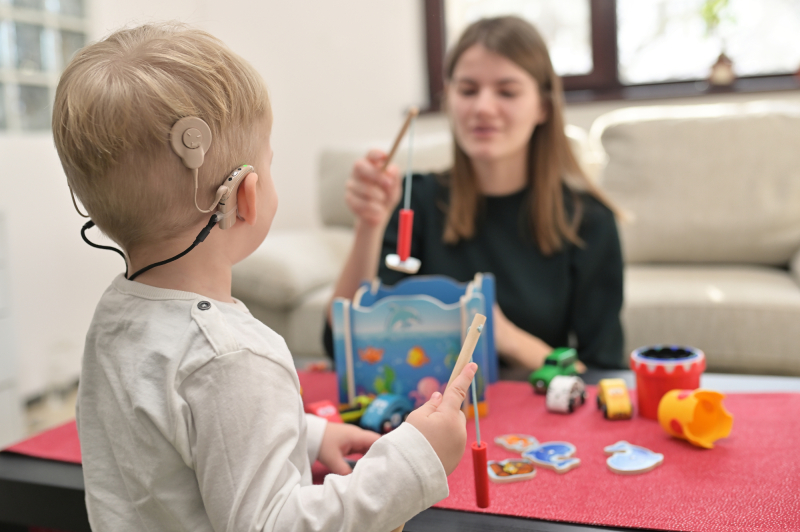
A child with a cochlear implant. Credit: jordache / photogenica.ru
Margarita often uses speech recognition software when she’s around the hearing. It’s one of the simplest and most accessible tools that helps the deaf and hard of hearing understand spoken words. Another obvious way towards a more inclusive environment is using subtitles. However, according to Margarita they won’t be able to replace sign language.
“Subtitles won’t be enough to replace sign language – for instance, because not all deaf people are literate. Whereas subtitles might be enough in movies, they won’t be as helpful for popular science lectures. The latter are laden with complex terms that the deaf and hard of hearing might find hard to understand; therefore, they need to be translated into sign language. Ideally, lectures would have both subtitles and sign language interpretation: then we will be able to understand the information and improve our spoken Russian by learning new words,” says Margarita.
She is certain that the deaf will find it easier to receive information about the world around them if the hearing learn the basics of sign language. It is particularly relevant for clinicians, the police, emergency services, and the service industry.
Sign language can be learned by anyone – for some, it takes mere weeks to learn the basics, while others spend months getting into the structure of the language. Russian sign language is taught at paid courses and in St. Petersburg you can even learn it for free at the Tatsida sign language school (available for people from 14 to 35).
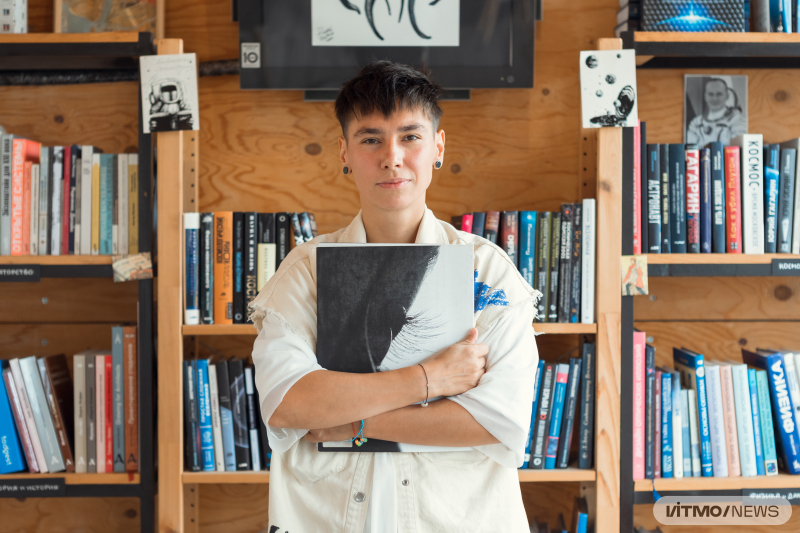
Margarita Nikulina. Photo by Dmitry Grigoryev / ITMO.NEWS
“I am comfortable in the world of the hearing because I am hard of hearing and I need to work on my voice. The deaf, however, find it uncomfortable: many admit that they have difficulties – for instance, when they can’t receive adequate help at a hospital without an interpreter. That’s why it would have been great if important information was translated into sign language,” adds Margarita Nikulina.
In the future, Margarita is planning to finish her career as a footballer and become a coach, as well as learn English in its spoken and sign language forms.
